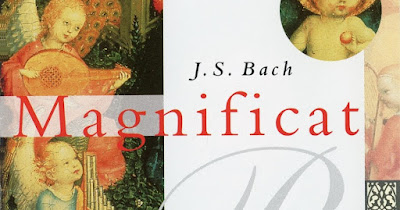Bach Magnifcat
The Magnificat in E-flat major, BWV 243a, also BWV 243.1, by Johann Sebastian Bach is a musical setting of the Latin text of the Magnificat, Mary's canticle from the Gospel of Luke. It was composed in 1723 and is in twelve movements, scored for five vocal parts (two sopranos, alto, tenor and bass) and a Baroque orchestra of trumpets, timpani, oboes, strings and basso continuo including bassoon. Bach revised the work some ten years later, transposing it from E-flat major to D major, and creating the version mostly performed today, BWV 243.
The work was first performed in Leipzig in 1723. In May that year Bach assumed his position as Thomaskantor and embarked on an ambitious series of compositions. The Magnificat was sung at vesper services on feast days, and, as suggested by recent research, Bach's setting may have been written for a performance on 2 July, celebrating the Marian feast of the Visitation. For a Christmas celebration the same or a later year, he performed it at the Nikolaikirche with the insertion of four seasonal movements.
As a regular part of vespers, the canticle Magnificat was often set to music for liturgical use. Bach, as some of his contemporaries, devotes individual expression to every verse of the canticle, one even split in two for a dramatic effect. In a carefully designed structure, four choral movements are evenly distributed (1, 4, 7, 11). They frame sets of two or three movements sung by one to three voices, with individual instrumental colour. The work is concluded by a choral doxology (12), which ends in a recapitulation of the beginning on the text "as it was in the beginning". In Bach's Leipzig period, Magnificat is the first major work on a Latin text and for five vocal parts. - Wikipedia
Choir of Christ Church Cathedral Oxford
The Academy of Ancient Music - conducted by Simon Preston
Judith Nelson - Soprano
Emma Kirkby - Soprano
Carolyn Watkinson - Alto
Paul Elliott - Tenor
David Thomas - Bass
Recorded in 1978 at St Jude's, Hampstead, London, England.
Please enjoy the performance!
00:00 1. Chorus
Magnificat anima mea Dominum
03:15 2. Aria (Soprano 2)
Et exsultavit spiritus meus
05:29 2a. Chorus
Vom Himmel hoch, da komm ich her
07:51 3. Aria (Soprano 1)
Quia respexit humilitatem
10:32 4. Chorus
Omnes generationes
11:58 5. Aria (Bass)
Quia fecit mihi magna
14:02 5a. Chorus
Freut euch und jubiliert
15:29 6. Aria (Alto, Tenor)
Et misericordia a progenie
19:17 7. Chorus
Fecit potentiam in brachio suo
21:24 7a. Chorus
Gloria in excelsis Deo!
22:32 8. Aria (Tenor)
Deposuit potentes de sede
24:30 9. Aria (Alto)
Esurientes implevit bonis
27:26 9a. Aria (Soprano 1, Bass)
Virga Jesse floruit
30:21 10. Aria (Soprano 1, Soprano 2, Alto)
Suscepit Israel puerum suum
32:08 11. Chorus
Sicut locutus est ad Patres nostros
33:36 12a. Chorus
Gloria Patri, gloria Filio
34:40 12b. Chorus
Sicut erat in principio
Biblical quotations in green font, chorales in purple | |||||
|
1 |
Chorus [S, S, A, T, B] |
||||
|
Tromba I-III, Timpani, Flauto traverso I/II, Oboe I/II, Violino I/II, Viola, Continuo |
|||||
|
Magnificat anima mea Dominum. |
|||||
|
2 |
Aria [Soprano II] |
||||
|
Violino I/II, Viola, Continuo |
|||||
|
Et exsultavit spiritus meus in Deo salutari meo
Vom Himmel hoch, da komm ich her, |
|||||
|
3 |
Aria [Soprano I] |
||||
|
Oboe d'amore I, Continuo |
|||||
|
Quia respexit humilitatem ancillae suae; |
|||||
|
4 |
Chorus [S, S, A, T, B] |
||||
|
Flauto traverso I/II, Oboe d'amore I/II, Violino I/II, Viola, Continuo |
|||||
|
Omnes generationes. |
|||||
|
5 |
Aria [Bass] |
||||
|
Continuo |
|||||
|
Quia fecit mihi magna qui potens est, et sanctum nomen eius.
Freut euch und jubiliert; |
|||||
|
6 |
Aria (Duet) [Alto, Tenor] |
||||
|
Flauto traverso I e Violino I all' unisono, Flauto traverso II e Violino II all' unisono, Viola, Continuo |
|||||
|
Et misericordia a progenie in progenies timentibus eum. |
|||||
|
7 |
Chorus [S, S, A, T, B] |
||||
|
Tromba I-III, Timpani, Flauto traverso I/II, Oboe I/II, Violino I/II, Viola, Continuo |
|||||
|
Fecit potentiam in brachio suo, dispersit superbos mente cordis sui. |
|||||
|
8 |
Aria [Tenor] |
||||
|
Violini all' unisono, Continuo |
|||||
|
Deposuit potentes de sede et exaltavit humiles. |
|||||
|
9 |
Aria [Alto] |
||||
|
Flauto traverso I/II, Continuo |
|||||
|
Esurientes implevit bonis et divites dimisit inanes. |
|||||
|
10 |
Aria (Terzetto) [Sopranos I and II, Alto] |
||||
|
Oboe I/II all' unisono, Organo e Violoncelli senza, Violone e Bassoni |
|||||
|
Suscepit Israel puerum suum recordatus misericordiae suae. |
|||||
|
11 |
Chorus [S, S, A, T, B] |
||||
|
Continuo |
|||||
|
Sicut locutus est ad Patres nostros, |
|||||
|
12 |
Chorus [S, S, A, T, B] |
||||
|
Tromba I-III, Timpani, Flauto traverso I/II, Oboe I/II, Violino I/II, Viola, Organo e Continuo |
|||||
|
Gloria Patri, gloria Filio, |
|||||
| Note: Many translations of this text use familiar versions based on translations of the Greek text of Luke 1: 46-55. This translation may seem different because it is intended to offer help to those who wish to follow the Latin and is therefore literal in some places and elsewhere expansive in making explicit the implications of some words | |||||
| English Translation by Francis Browne (September 2006) | |||||


Comments
Post a Comment
Please leave a comment. I appreciate your feedback. Thanks!